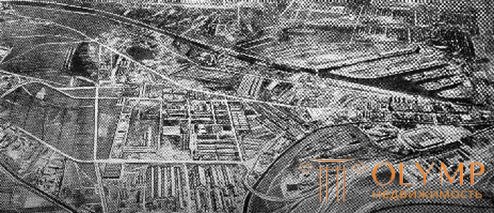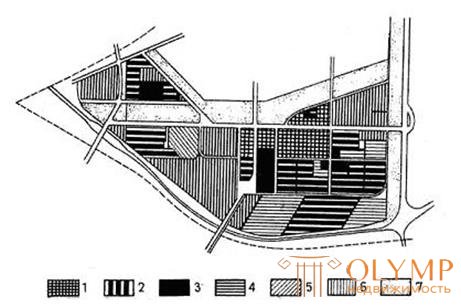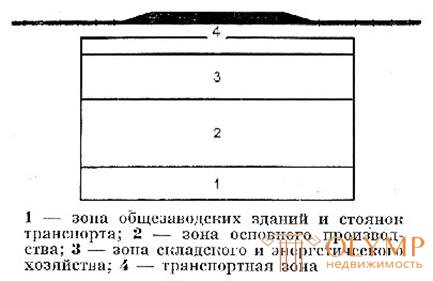
Definition: the industrial zone of the city consists of urban industrial areas, which are formed on the basis of co-operation of enterprises, auxiliary and service facilities, engineering structures.

Fig. 167. Industrial area in Manchester
For most of the largest industrial cities that have gone through a significant development path, the formation of industrial belts, which developed under the conditions of rapid industrial development, is characteristic (Fig. 167). The location of industrial enterprises in the city was often dictated by the existing system of railways (Fig. 168).

Fig. 168. The influence of the configuration of the railways on the location of industrial enterprises in the cities of Siberia
Many industrial enterprises are sources of harmful emissions and negatively affect the state of the environment. The location of industrial enterprises in the structure of the city depends on the degree of their environmental hazard.
Harm class | Standard size of sanitary protection zone |
one | 1000 m |
2 | 500 m |
3 | 300 m |
four | 100 m |
five | 50 m |
The standard size of the sanitary protection zone (SPZ) is established for an enterprise depending on its hazard class, but the SPZ boundaries can be reduced if work is done on calculating pollution (the SPZ project, Fig. 169) and identifying actual emissions of harmful substances into the atmosphere.

Fig. 169. Draft sanitary protection zone
The size and configuration of the boundary of the sanitary protection zone is influenced by the direction of the prevailing winds, the location (height) of the emission pipes, the location of the enterprise, the nature of measures to reduce harmful emissions (Fig. 170).

Fig. 170. Scheme of deposition of dust particles under unstable weather conditions.
The hazard class affects the location of an industrial plant. Companies of the 1st class should be located outside the residential zone (chemical industry, oil refining, steel mills, etc.). In the structure of the residential zone can be located enterprises with a sanitary-protective zone up to 50 m. (Fig. 171).
 Fig. 171. Location of industrial areas in the city
Fig. 171. Location of industrial areas in the city
1 - remote from the residential area;
2 - on the border of the residential area;
3 - within the residential area.
At the heart of industrial areas are industrial sites, which are formed on the basis of the association and cooperation of enterprises. As a rule, industrial areas have a clear regular planning structure, most often it is a quarterly system (fig. 172-174).

Fig. 172. Functional zoning of the production area:
1 - industrial enterprises; 2 - scientific institutions; 3 - administrative and technical centers; 4 - urban transport enterprises; 5 - utilities;
6 - warehouses; 7 - landscaping

Fig. 173. Schematic diagram of the zoning of the industrial enterprise

Fig. 174. The layout of the industrial district of Tolyatti:
1 - Volzhsky Automobile Plant; 2 - industrial-communal zone; 3 - production base of construction; 4 - CHP; 5 - asphalt plant; 6 - sludge pits; 7 - waste recycling plant; 8 - sewage treatment plants; 9 - cargo yard
Что бы оставить комментарий войдите
Комментарии (0)